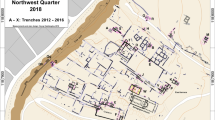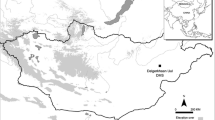Abstract
New archaeological finds at the Celtic oppidum (site) of Tarodunum/Kirchzarten, near Freiburg (South-Germany, Black-Forest Region) and their analytical evaluation add another chapter to the still enigmatic Celtic metallurgy, especially in relation to the production of gold/silver/copper alloys for coinage.
Similar content being viewed by others
References
See Didor 16, 8, 5–7; Herodot 7, 112.9, 75; Euripides, Rhesos, 921–922; Xenophon, Hellenika 5, 2, 17; Strabo 7, 33.34.36; Plinius, Natural History 7, 197 and G. Le Rider in ‘The Coinage of Philip and the Pangaion Mines’ (in: M.B.Hatzopoulos, L.D.Loukopoulos (Eds) ‘Philip of Macedon’, Athens 1980, pp. 48–49 and for detailed discussion D.Keller in ‘Gedanken zur Datierung und Verwendung der Statere Philipps II und ihrer Keltischen Imitationen, Schweizerische Numismatische Rundschau’, 1996,75, 101–120.
Results of ten unpublished ED-XRF analysis of Philippou-staters in private collections Geochemical Laboratory MPI, Basel University); the fineness comes close to Au 990 with the additional Cu and Ag contents adding up to ca 1 wt%, which means refined gold has been struck.
For detailed discussion of this particular problem see G. Le Rider, ‘Le Monnayage d’Argent et d’Or de Philippe II Frappé en Macedoine de 359 à 294’, Paris 1977 and M.Price, ‘The Coinage in the Name of Alexander the Great and Philip Arrhidaeus’, A British Museum Catalogue (The Swiss Numismatic Society in association with the British Museum Press), Zürich/London 1991 (2 volumes, 637pp, 159 plates).
For archaeological dating of Celtic coins found in burials see H. Polenz, ‘Münzen in Latènezeitlichen Gräbern Mitteleuropas aus der Zeit Zwischen 300 und 50 v.Chr. Bayerische Vorgeschichtsblätter’ 1982,47, 27–222.
D.F. Allen, ‘The Philippus in Switzerland and the Rhineland, Schweizerische Numismatische Rundschau’, 1974,53, 42–74; H.Polenz -op cit(4) ‘Münzen in Latènezeitlichen Gräbern Mitteleuropas aus der Zeit Zwischen 300 und 50 v.Chr. Bayerische Vorgeschichtsblätter’ 1982,47, 27–222. One Philippou type called the ‘Quarter Stater of Horgen-Unterentfelden’ is very common in Switzerland (see K. Castelin, ‘Keltische Münzen. Katalog der Sammlung des Schweizerischen Landesmuseums Zürich, Stäfa’,1978, coins No 878 to 903 and 921 to 933) and is well dated to the first part of the second century BC.
First verified by A. Burkhardt, W.B. Stern, G. Helmig, ‘Keltische Münzen aus Basel. Numismatische und metallanalytische Untersuchungen [KMBS]’, Antiqua 25, Basel 1994 (434pp, 300 figures) see pp. 86-88, Figure 87, p.117 and W.B.Stern, ‘On Non-Destructive Analysis of Gold Objects’ in ‘Prehistoric Gold in Europe. Mines, Metallurgy and Manufacture’ (Eds. G. Morteani, J.P. Northover, NATO ASI Series),Applied Sciences, 1995,280, 317–328 — contrary to common numismatic opinion (R.D. van Arsdell, ‘Celtic Coinage of Britain’, London 1989).
A. Burkhardt, W.B. Stern, G. Helmig, KMBS 1994 (op cit(6) ‘Keltische Münzen aus Basel. Numismatische und metallanalytische Untersuchungen [KMBS]’, Antiqua 25, Basel) and A. Burkhardt, R. Dehn, H.G. Bachmann and W.B. Stern, ‘Keltische Münzen aus latènezeitlichen Siedlungen des Breisgau in ‘Numismatische und Archäometallurgische Untersuchungen’ to be published - this monograph will also give the complete record of the archeological excavation and details of the finds.
See (7) and for a numismatic-analytical synopsis of all coin finds of the Upper Rhine Valley see A. Burkhardt, ‘Quantitative Methoden zur Keltischen Numismatik am Beispiel der Münzfunde aus Latènezeitlichen Siedlungen der Oberrheinregion’, Verlag Paul Haupt, Bern, 1998 (108pp., 59 figures).
See R.D. van Arsdell, 1986 (op.cit.(6) ‘On Non-Destructive Analysis of Gold Objects’ in ‘Prehistoric Gold in Europe. Mines, Metallurgy and Manufacture’ (Eds. G. Morteani, J.P. Northover, NATO ASI Series),Applied Sciences, 1995,280, 317–328 — contrary to common numismatic opinion (R.D. van Arsdell, ‘Celtic Coinage of Britain’, London 1989)) and R.D. van Arsdell, ‘Take out the Gold but Keep the Colour, Numismatic Circular (Spink), 1989,97, 83f and J.P. Northover, ‘Materials Issues in the Celtic Coinage’, BAR 222, ‘Celtic Coinage: Britain and Beyond’ (The Eleventh Oxford Symposium on Coinage and Monetary History, Ed. M.Mays), Oxford 1992, pp.235-300.
Cat.-No 1-5 in A. Burkhardt, R. Dehn, H.G. Bachmann and W.B. Stern (op cit (7) ‘Keltische Münzen aus Basel. Numismatische und metallanalytische Untersuchungen [KMBS]’, Antiqua 25, Basel) and A. Burkhardt, R. Dehn, H.G. Bachmann and W.B. Stern, ‘Keltische Münzen aus latènezeitlichen Siedlungen des Breisgau in ‘Numismatische und Archäometallurgische Untersuchungen’ to be published — this monograph will also give the complete record of the archeological excavation and details of the finds.).
For details of hard- and software see W.B. Stern in KMBS 1994 (op cit (6) ‘Keltische Münzen aus Basel. Numismatische und metallanalytische Untersuchungen [KMBS]’, Antiqua 25, Basel), p.80.
For a discussion of and recent research on coin moulds see R. Gebhard, G. Lehrberger, G. Morteani, Ch. J. Raub, F.E. Wagner and U. Wagner, ‘Coin Moulds and Other Ceramic Materials: A Key to Celtic Precious Metal Working’ in ‘Prehistoric Gold in Europe’ ed. G. Morteani and J.P. Northover, Kluwer Academic Publishers, Dordrecht/Boston/London, 1995, pp. 273–301.
See W.B. Stern in KMBS 1994, pp.86–87 and Figures 86, 87; W.B. Stern 1995 (op cit(6) ‘Keltische Münzen aus Basel. Numismatische und metallanalytische Untersuchungen [KMBS]’, Antiqua 25, Basel) and in detail (illustrated) forthcoming in A. Burkhardt, R. Dehn, H.G. Bachmann and W.B. Stern (op cit (7) ‘Keltische Münzen aus latènezeitlichen Siedlungen des Breisgau in ‘Numismatische und Archäometallurgische Untersuchungen’ to be published - this monograph will also give the complete record of the archeological excavation and details of the finds.).
For SEM a Jeol 6300 and Philips 505 were used in the REM Laboratory of Prof. Dr. R. Guggenheim (Department of Earth Sciences Basel University). Thanks are due to M. Düggelin and D. Mathys. Additional measurements were carried out by H. Everts at the Degussa Research Centre, Hanau (Germany). His assistance is also much appreciated.
C.F. Rammelsberg,’Lehrbuch der Chemischen Metallurgie’, Berlin, 1850, pp. 210–211; C. Schnabel, ‘Handbuch der Metallhüttenkunde’, Vol 1, Tables 6 and 7, Berlin 1894; V. Tafel and K. Wagermann, ‘Lehrbuch der Metallhüttenkunde’, Vol 1, 2nd ed., Leipzig, 1951, p. 424.
T.T. Chen and J.E. Dutriac, ‘Mineralogical characterisation of anode slimes. IV. Copper-Nickel-Antimony-Oxide ‘Kupferglimmer’ in ‘CRR Anodes and Anode Slimes’ Canadian Metallurgical Quarterly, 1989, 28 (2), 127–134.
G. Goldenberg, J. Otto and H. Sreuer (eds.), ‘Archäometallurgische Untersuchungen zum Metallhüttenwesen im Schwarzwald’, Sigmaringen 1996, p 18; and also A. Foellmer, A. Hoppe and R. Dehn ‘Anthropogene Schwermetallanreicherungen in holozänen Auensedimenten der Möhlin’, (südlicher Oberrheingraben), Geowissenschaften 15, 1997, 2, 61–66.
Author information
Authors and Affiliations
Additional information
Prof Dr Hans-Gert Bachmann studied chemistry, mineralogy and geology. He became involved in archaeometallurgical research in the mid-fifties. Until his retirement he was senior research scientist with Degussa. He held teaching appointments at the Institute of Archaeology, University College London, and at the University of Frankfurt/Main (Germany).
Dr Andreas Burkhardt studied archeology, human anthropology and history at the universities of Münster and Freiburg (Germany) and Basel (Switzerland). For over ten years he has carried out interdisciplinary work in the Geochemical Laboratory (Department of Earth Sciences) and in the Institute for Prehistoric Archaeology (both Basel University, Switzerland). He now runs his own company, the ‘Institute for Non-Destructive Analysis and Archaeometry’ in Bern, Switzerland.
Dr Rolf Dehn is head conservator of the Archaeological Department, Landesdenkmalamt Freiburg/Breisgau (Black-Forest). He has been responsible for all archaeological finds and excavations since 1977.
Prof Dr Willem B Stern, a mineralogist by training, is head of the Geochemical Laboratory (Department of Earth Sciences, Basel University). He is a specialist in non-destructive material characterization and forensic analyses of antique and modern artefacts.
Rights and permissions
About this article
Cite this article
Bachmann, H.G., Burkhardt, A., Dehn, R. et al. New Aspects of Celtic Gold Coinage Production in Europe. Gold Bull 32, 24–29 (1999). https://doi.org/10.1007/BF03214786
Issue Date:
DOI: https://doi.org/10.1007/BF03214786




